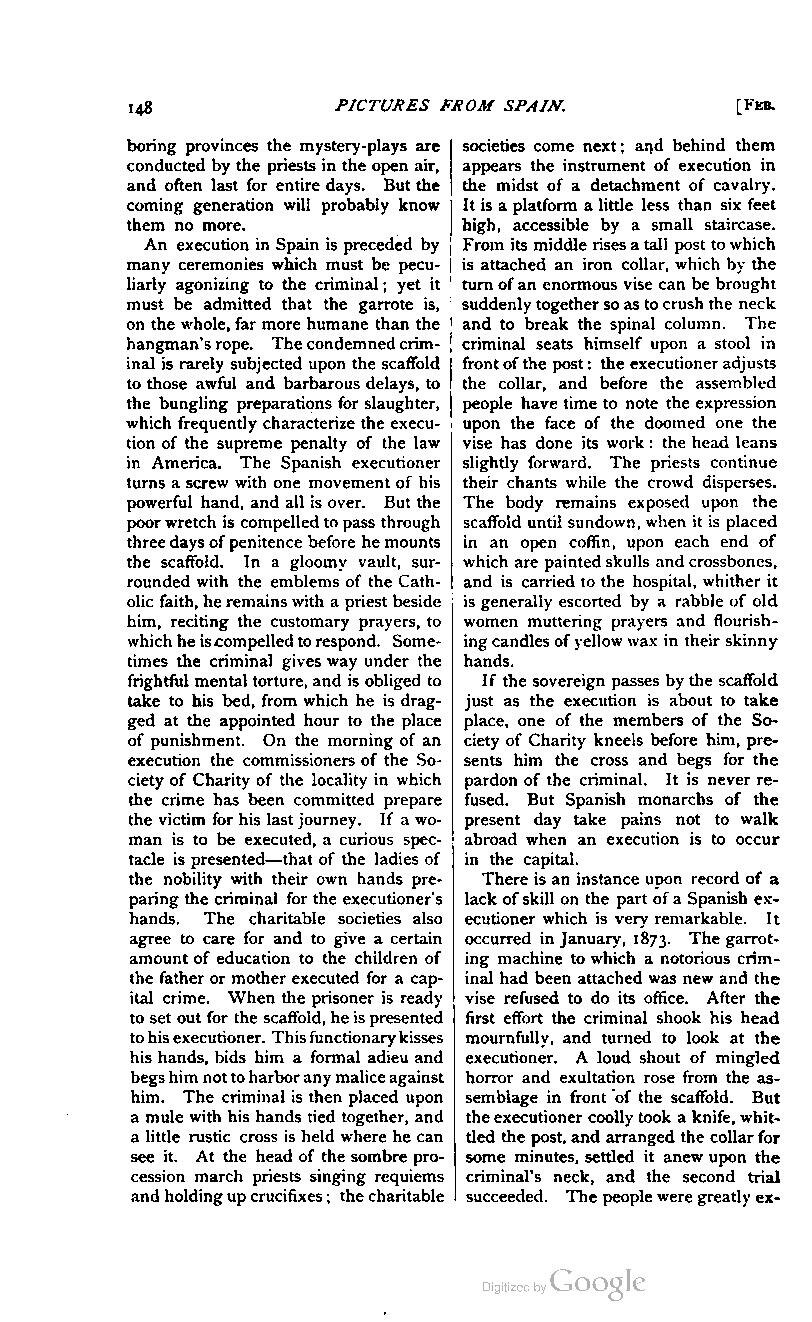{{hwe|boring|neighboring provinces the mystery-plays are conducted by the priests in the open air, and often last for entire days. But the coming generation will probably know them no more.
An execution in Spain is preceded by many ceremonies which must be peculiarly agonizing to the criminal; yet it must be admitted that the garrote is, on the whole, far more humane than the hangman's rope. The condemned criminal is rarely subjected upon the scaffold to those awful and barbarous delays, to the bungling preparations for slaughter, which frequently characterize the execution of the supreme penalty of the law in America. The Spanish executioner turns a screw with one movement of his powerful hand, and all is over.
But the poor wretch is compelled to pass through three days of penitence before he mounts the scaffold. In a gloomy vault, surrounded with the emblems of the Catholic faith, he remains with a priest beside him, reciting the customary prayers, to which he is compelled to respond. Sometimes the criminal gives way under the frightful mental torture, and is obliged to take to his bed, from which he is dragged at the appointed hour to the place of punishment. On the morning of an execution the commissioners of the Society of Charity of the locality in which the crime has been committed prepare the victim for his last journey. If a woman is to be executed, a curious spectacle is presented—that of the ladies of the nobility with their own hands preparing the criminal for the executioner's hands. The charitable societies also agree to care for and to give a certain amount of education to the children of the father or mother executed for a capital crime. When the prisoner is ready to set out for the scaffold, he is presented to his executioner. This functionary kisses his hands, bids him a formal adieu and begs him not to harbor any malice against him. The criminal is then placed upon a mule with his hands tied together, and a little rustic cross is held where he can see it. At the head of the sombre procession march priests singing requiems and holding up crucifixes; the charitable societies come next; and behind them appears the instrument of execution in the midst of a detachment of cavalry. It is a platform a little less than six feet high, accessible by a small staircase. From its middle rises a tall post to which is attached an iron collar, which by the turn of an enormous vise can be brought suddenly together so as to crush the neck and to break the spinal column. The criminal seats himself upon a stool in front of the post: the executioner adjusts the collar, and before the assembled people have time to note the expression upon the face of the doomed one the vise has done its work: the head leans slightly forward. The priests continue their chants while the crowd disperses. The body remains exposed upon the scaffold until sundown, when it is placed in an open coffin, upon each end of which are painted skulls and crossbones, and is carried to the hospital, whither it is generally escorted by a rabble of old women muttering prayers and flourishing candles of yellow wax in their skinny hands.
If the sovereign passes by the scaffold just as the execution is about to take place, one of the members of the Society of Charity kneels before him, presents him the cross and begs for the pardon of the criminal. It is never refused. But Spanish monarchs of the present day take pains not to walk abroad when an execution is to occur in the capital.
There is an instance upon record of a lack of skill on the part of a Spanish executioner which is very remarkable. It occurred in January, 1873. The garroting machine to which a notorious criminal had been attached was new and the vise refused to do its office. After the first effort the criminal shook his head mournfully, and turned to look at the executioner. A loud shout of mingled horror and exultation rose from the assemblage in front of the scaffold. But the executioner coolly took a knife, whittled the post, and arranged the collar for some minutes, settled it anew upon the criminal's neck, and the second trial succeeded. The people were greatly ex-
